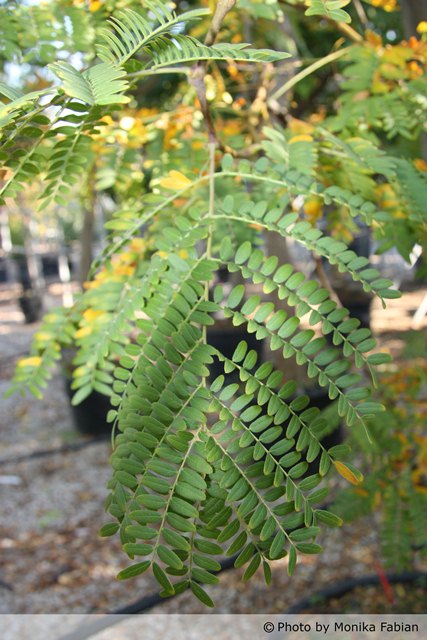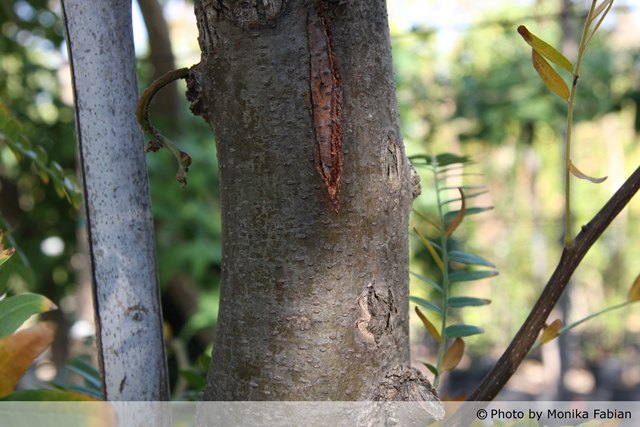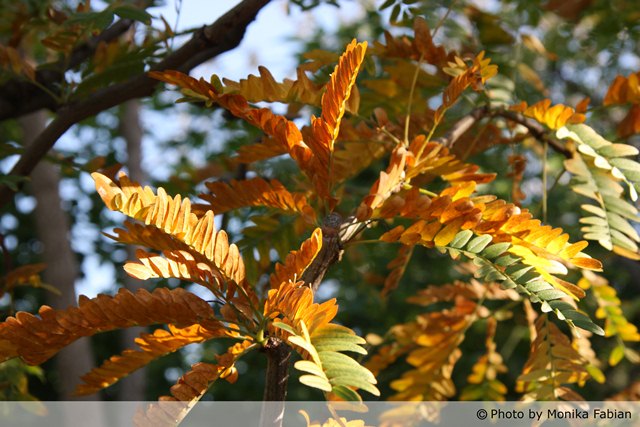Gleditsia triacanthos f. inermis (Thornless Honeylocust)
Thornless honeylocust is the landscape variety of Imperial Honeylocust, but thornless and sometimes seedless. Its leaves are both bipinnately compound and pinnately compound, and turn yellow to gold in fall. The seedpods in fall are not appealing and are a litter problem. It has no soil preference and can tolerate compacted soil as well as flooding and confined spaces. Overuse of this tree can lead to insect and disease problems, so plant in moderation.
- Landscape Information
- Botanical Description
- Horticulture Management
-
By Bostonian13 (Own work) [CC-BY-SA-3.0 (http://creativecommons.org/licenses/by-sa/3.0)], via Wikimedia Commons
-
Andrew Butko [GFDL 1.3 (www.gnu.org/licenses/fdl-1.3.html) or CC-BY-SA-3.0 (http://creativecommons.org/licenses/by-sa/3.0)], via Wikimedia Commons
-
-
-
-
Search plant on Google
Download as PDF
-
French Name: Févier d'Amérique, Carouge à miel
Arabic Name: غلاديشية ثلاثية الأشواك
Pronunciation: gleh-DIT-see-uh try-uh-KANTH-oase ih-NER-miss
-
Plant type: Tree
-
Origin: Central and Eastern United States
-
Heat Zones: 1 to 9
Hardiness Zones: 3 to 9
-
Uses: Specimen, Shade, Street, Pollution Tolerant / Urban, Reclamation
-
Size/Shape
Growth Rate: Fast
Tree Shape: Round, oval
Canopy Symmetry: Irregular
Canopy Density: Open
Canopy Texture: Fine
Height at Maturity: 15 to 23 m
Spread at Maturity: 10 to 15 meters
-
By Bostonian13 (Own work) [CC-BY-SA-3.0 (http://creativecommons.org/licenses/by-sa/3.0)], via Wikimedia Commons
-
Andrew Butko [GFDL 1.3 (www.gnu.org/licenses/fdl-1.3.html) or CC-BY-SA-3.0 (http://creativecommons.org/licenses/by-sa/3.0)], via Wikimedia Commons
-
-
-
-
Search plant on Google
Download as PDF
-
Foliage
Leaf Arrangement : Alternate
Leaf Venation: Pinnate
Leaf Persistance: Deciduous
Leaf Type: Bipinnately compound
Leaf Blade: Less than 5
Leaf Shape: Oblong
Leaf Margins: Crenate
Leaf Texture: Fine
Leaf Scent: No Fragance
Color(growing season): Green
Color(changing season): Yellow, Copper
-
Flower
Flower Size Range: 1.5 - 3
Flower Type: Catkin
Flower Sexuality: Monoecious (Bisexual)
Flower Scent: No Fragance
Flower Color: Green, Yellow
Seasons: Spring
-
Trunk
Trunk has Crownshaft: No
Trunk Susceptibility to Breakage: Generally resists breakage
Number of Trunks: Single Trunk
Trunk esthetic Values: Showy, Fissured
-
Fruit
Fruit Type: Legume
Fruit Showiness: Yes
Fruit Size Range: 10 - 20, Over 20 cm
Fruit Color: Brown, Red, Purple
Seasons: Spring
-
By Bostonian13 (Own work) [CC-BY-SA-3.0 (http://creativecommons.org/licenses/by-sa/3.0)], via Wikimedia Commons
-
Andrew Butko [GFDL 1.3 (www.gnu.org/licenses/fdl-1.3.html) or CC-BY-SA-3.0 (http://creativecommons.org/licenses/by-sa/3.0)], via Wikimedia Commons
-
-
-
-
Search plant on Google
Download as PDF
-
Tolerance
Frost Tolerant: Yes
Salt Tolerance: Good
-
Requirements
Soil Requirements: Clay, Loam, Sand
Soil Ph Requirements: Acidic, Neutral, Alkaline
Light Requirements: Full
-
Management
Susceptibility to Pests and Diseases: No
Pruning Requirements: Needed, to develop a strong structure
Fruit/ Leaves/ Flowers litter: Yes
Surface Rooting: Yes
Life Span: More than 50
Diseases: Powdery Mildew, Leaf Spots, Canker
Edible Parts: None
Pests: Mites, Caterpillars, Aphids, Leaf Miner, Borers, Midges
Plant Propagation: Seed




